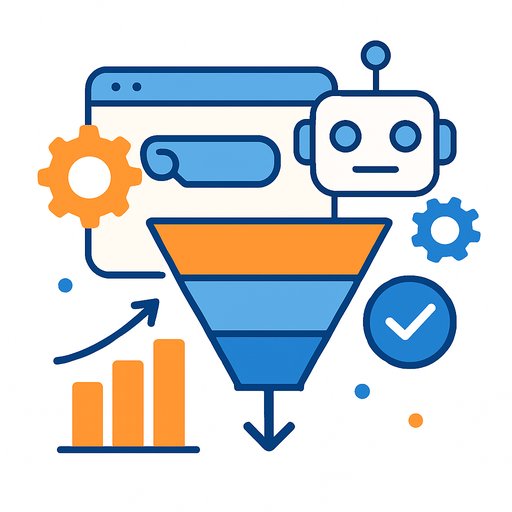AI search is collapsing the B2B buyer path
AI-powered search is rewriting how buyers find, compare and choose solutions. Tools like ChatGPT, Perplexity and Google's AI Overviews answer complex questions directly, often without a click. That rewards credibility and depth over generic traffic plays.
For B2B marketers, the target isn't pageviews - it's being the source AI cites. Authority wins. Content that's specific, verifiable and easy for machines to parse earns visibility, qualified intent and deals.
From three-stage funnel to answer-first discovery
Old playbooks centered on keywords and linear funnels. A prospect searched, scanned links and moved step by step from awareness to purchase. You controlled the path with gated assets and nurture tracks.
Now, buyers ask nuanced questions and get synthesized, conversational answers in-line. Queries like "best CRM for a mid-sized SaaS company" return summaries, comparisons and reviews pulled from a handful of credible sources. That concentrates attention and compresses the path to a shortlist.
Expect lower organic traffic overall. Some studies project a 50%+ decline by 2028. At the same time, AI-driven discovery already contributes 2%-6% of B2B organic traffic - small, but growing, and highly qualified.
How AI search changes each stage
Awareness: keywords give way to context
Broad content like "What is marketing automation?" is fading. AI interprets intent and surfaces precise answers to niche questions. Win early by addressing specific, high-intent prompts your buyers actually ask.
Example: instead of "B2B marketing automation," write "How a small B2B services firm can automate lead nurturing on a tight budget." Aim for depth, real numbers and clear takeaways.
Consideration: comparisons on command
Middle-of-funnel content still matters, but its job has shifted. AI tools extract and present comparisons, features and trade-offs directly in results. If your data is messy or vague, you're invisible in those summaries.
Make your comparisons scannable and machine-readable. Use clear headings, consistent terminology, structured lists and supporting visuals or tables. If AI can parse it, buyers will see it.
Decision: proof and trust need to be explicit
At the final step, buyers want validation. AI surfaces case studies, ROI snapshots, testimonials and pricing notes - the receipts. If you've published them clearly and consistently, you'll show up.
Prioritize transparent pricing ranges, outcomes by segment, implementation timelines and risk-mitigation details. Keep claims verifiable and consistent across site, profiles and review platforms.
The hard parts marketers must face
- Zero-click behavior: AI Overviews often appear first, which can reduce clicks to your site. Track share of voice in AI answers, brand mentions and assisted conversions - not just sessions.
- Authority squeeze: When AI condenses results, only a few sources get cited. In a flood of AI-generated noise, original research, expert commentary and unique frameworks stand out.
- Data control: If models summarize outdated or off-brand info, your narrative suffers. Keep public data accurate, fresh and consistent. Monitor how your brand appears in AI answers.
What to do next: a practical playbook
Optimize for conversational queries
- Create deep FAQ hubs that mirror buyer questions by role, industry and maturity. Target long-tail prompts and edge cases.
- Write the way your customers speak. Short sentences. Clear verbs. Direct answers. Then add a brief "what to do" section.
- Publish step-by-step how-to guides with screenshots, templates and checklists. Add metrics, pitfalls and decision criteria.
Double down on authority and trust (E-E-A-T)
- Show real experience: first-party data, case studies with numbers, and quotes from practitioners.
- Highlight expertise: author bios, credentials and editorial standards. Keep claims sourced and current.
- Build authoritativeness: earn mentions and backlinks from reputable publications, partners and customers.
- Reinforce trust: HTTPS, transparent contact details, updated product facts, and consistent messaging.
Useful reference on helpful, reliable content: Google Search Central guidance.
Make content machine-readable
- Use schema markup (Product, FAQPage, Review, Article) to label facts. Keep naming conventions consistent across pages.
- Standardize comparison formats: same attributes, same units, same order. Avoid jargon when a common term exists.
- Summarize each page with a crisp TL;DR and a bullet list of key facts. That's easy for humans and AI to extract.
Learn more: Schema.org.
Use AI to compete (not just to create)
- Analyze SERP answers for your topics: which sources get cited, what data they show and where your gaps are.
- Run prompt testing to see how AI tools answer buyer questions in your category. Adjust your pages to fill missing proof.
- Adopt tools for predictive topics, content scoring and entity analysis to plan what to publish next.
Measure beyond clicks
- Track brand citations in AI answers, inclusion in overviews and share of voice on key prompts.
- Attribute assisted impact: saved comparisons, demo requests after AI exposure, and pipeline quality by entry point.
- Balance "volume" with "value": fewer visits, higher intent, faster sales cycles.
Content formats that AI consistently cites
- Comparison matrices: standardized features, pricing tiers, integrations, security, support SLAs.
- ROI calculators and outcome snapshots: assumptions, ranges, industry benchmarks and time-to-value.
- Implementation timelines: roles, dependencies, week-by-week milestones and common blockers.
- Customer proof: named case studies with metrics, segment tags and quotes tied to outcomes.
- Glossaries and definition pages: canonical explanations for category terms and entities.
Team and workflow shifts that help
- Assign topic ownership to subject-matter experts, not just writers. Publish fewer pieces with more depth.
- Refresh high-potential pages quarterly: update data, tighten summaries, add comparisons and cite sources.
- Create a "facts bank" with approved stats, claims and definitions. Reuse it across pages for consistency.
- Partner with customers for co-created proof: benchmarks, teardown webinars and field notes.
What's next
AI will personalize discovery by company size, stack, constraints and timing. The sources it trusts today will anchor those experiences tomorrow. Brands that invest in clarity, proof and structure now will own the shortlist later.
Shift your focus from ranking for head terms to earning citations on specific, high-intent prompts. Become the definitive answer in your niche. Traffic follows trust.
Level up your team's AI skills
If you want structured learning paths for marketers working with AI search, prompt design and automation, explore:
Your membership also unlocks:






